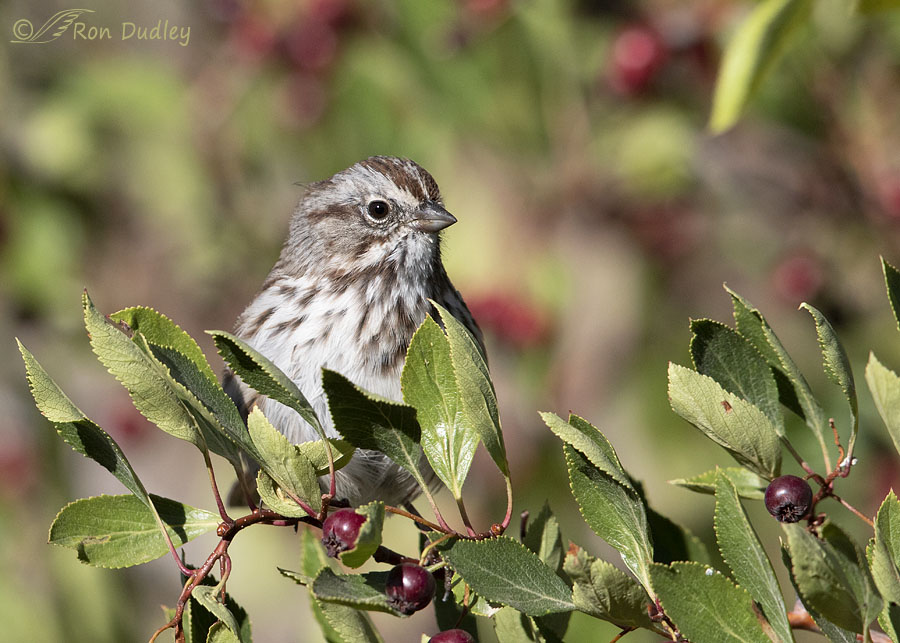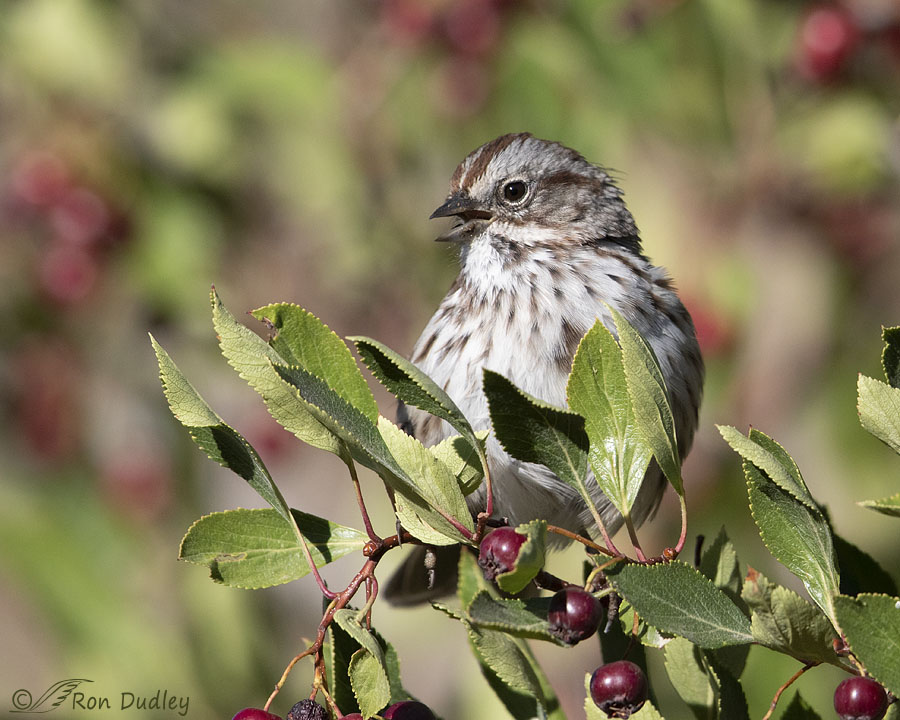Song Sparrows don’t generate a lot of excitement but I think this is an unusually handsome specimen in a pretty setting.

1/4000, f/6.3, ISO 800, Canon 7D Mark II, Canon EF 500mm f/4L IS II USM + EF 1.4 III Extender, not baited, set up or called in
In the mountains two days ago this Song Sparrow landed in a River Hawthorn quite close to me. For a few moments ‘he’ scurried around in the leaves as he apparently looked for food. But then he stopped here and looked directly into my pickup for a few moments as if he was curious about both my pickup and its contents. Clicking camera shutters probably contributed to his curiosity.
1/4000, f/6.3, ISO 800, Canon 7D Mark II, Canon EF 500mm f/4L IS II USM + EF 1.4 III Extender, not baited, set up or called in
This was about the extent of his pose variety but I was pleased to photograph such a dandy looking sparrow in an attractive setting like this. The bird and the entire perch are sharp, the leaves are in their prime and attractive and I think the foreground berries add a lot, complemented by the splotches of color provided by the out of focus berries in the background.
Typically in my photographs I prefer to have less of the bird hidden from view than this but in this case, because the leaves and berries are so attractive, I think the setting and the bird deserve equal billing.
As I roll along from day to day and month to month with Feathered Photography I sometimes become aware that once again I’ve been mostly ignoring many of the common species that contribute so much to our enjoyment of birds. When it comes to birds I don’t think ‘common’ implies less worth, it only means there are more of them. And that’s a good thing.
Imagine a world without the common species.
Ron



That second shoot is among my favorite photos you’ve ever posted. I have great fondness for the commoners as their delightful songs always lift my spirits. The beautiful colors here really set off the bird nicely. Winter is fast approaching (snow predicted here on the CO Front Range Tuesday) and I though I’ll miss my garden, most of all I’ll miss the birds.
I love your choice for today. A great common species as you like to relate it.
I continue to be challenged by connecting to your post but enjoy it and your reader’s comments daily.
Thank you for posting, Ron, and hope all is well.
Alice
I’m very sorry you’re having problems loading my posts, Alice. As far as I know it isn’t a problem originating at my end.
Fantastic!! The simple Sparrow makes for such a beautiful image and composition. Thanks for all your posts. I always look forward to them.
I appreciate your kind comment, Fred. Thank you.
“Dandy” is such a perfect descriptor! Everything about these shots brings a smile to my face. 😀
I’m glad you agree with my choice of the term, Marty. I was undecided for a while if it was the best choice.
Ron,
Oddly enough, the same species I photographed (among others) today. My best pics were of the song sparrow.
Thanks as always,
Stephen
I guess they’re called ‘common’ for good reason, Stephen. 🙂
As Dan pointed out, sometimes a “common” bird turns out to be suddenly unfamiliar. I was engaged in a nature exercise in which participants were asked to draw the face of a Blue Jay. As familiar as it seems to be, even the experts seemed to have trouble outlining that “familiar” face pattern.
Kenneth, I’m so unskilled at drawing I couldn’t do it no matter how familiar the subject.
That’s exactly why I often asked my students to draw no matter what their drawing skills were. It forces you to look closely. Is that eye strip a line completely through the eye, is it above the eye, does it only go from the eye rearward, etc.? If asked, you might know an eye line is present, such as on a Bewick’s Wren, but where is it precisely? Always a worthwhile exercise for anyone.
Common, shmommon. Many of the birds that you see often would have me in jaw-dropped amazement and delight. The same is probably true of ‘my’ birds.
I often turn to nature for solace and heart balm, and that is certainly very, very true at the moment.
As always, thank you.
There’s no ‘probably’ about it, EC. Many of your common birds would blow me away.
As yours do me.
I have always felt I take time to look, but not since the pandemic have I learned that I didn’t spend enough time looking at the individual plumage, and flight characteristics of birds. I know people won’t agree with me, but this pandemic has forced me to spend the time to look more deeply into what I see about the landscape. Keep those photographs coming, they are a high point of our day!! Stay safe.
Dick, I think a lot of folks are like you and looking more carefully at nature these days.
The 2nd picture is real nice. I love the colors in the background.
Thank you, Jean.
“Common” is in eye of beholder—I rarely see these little beauties in my yard (where I do most of my birdwatching these days), though I hear their song occasionally. So they obviously like to hide in the foliage — and this one picked the most photogenic foliage available, apparently. Really lovely photos, Ron!
““Common” is in eye of beholder”
Exactly, Chris. I imagine many birders in Northern Canada and much of Alaska would be pretty excited to find a Song Sparrow.
One of the essays in my book is on the problem of being common. People tend to take a quick look and then say “it’s just a Song Sparrow” or “it’s just a coot”. By doing so, people often miss some subtle and beautiful details as well as many wonderful behavioral details. I often gave my class a very detailed written description of an American Robin. I pointed out the broken eyering, the white streaks in the throat, the small white spots in the corner of the tail, and other details. However, I left out the obvious rusty color of the breast. Without that detail, the most obvious feature, almost no one ever knew what bird I was describing. Birders would look for such small details in an uncommon species to help distinguish it from another similar species, but the obvious red breast means that they often don’t bother to looker closer and many people don’t even realize these features are present and somewhat obvious. We also tend to ignore common species and their needs until we suddenly realize its numbers have declined to the point that it is no longer common. Thanks for the great photos. If side-by-side, your photos and a photo of our subspecies would show the subtle regional differences in this common species.
Very well said, Dan. I can’t imagine not having Song Sparrows around. Or robins.
Seeing an uncommon or “charismatic” bird brings a sense of excitement at an unusual discovery or experience , but I get a different and just as much satisfactory feeling from seeing the reliable and quotidian Goldfinch and Chickadee. Ditto for your daily selections (much enhanced by your photography and commentary).
Thank you, Lyle. I’ll confess, I had to look ‘quotidian’ up.
These are beautiful, the colors are perfect.
Thanks very much, April.
LBB’s are some of my favorites to watch in my yard. They are quite entertaining! And the berries in the first picture really make it pop. I prefer the first image over the second simply because the beak is closed. 😀
Interesting, Arwen. I suspect some folks might prefer the second image because his beak is open – you know, for the sake of variety.
I appreciated the colors in both photos, and in the second, the sharpness of the
serrated edges on the leaves perfectly echoed the overlapping shingles of feathers on the sparrow’s neck and breast…….I think it is a truly lovely image.
Thank you, Kris.
Very nice photo 😍 Yes the common little bird shines in a beautiful setting…no sign of rust or aphids, nice sheen on the berries…you made him a ‘rock star’.
Thanks, Kathy. He did a pretty good job of that rock star thing on his own.
Beautiful! Cute little sparrow in a wonderful setting of ripe(?) berries and green foliage…. 🙂 We, a humans, do tend to be drawn to the unusual – wonder if it’s a biological thing knowing what may be an “issue” and what isn’t? 😉
42 this morning but, so far, no wind……….
Judy, a friend on a ranch north of Cut Bank posted video of that wind yesterday on FB. She said it “blew the perm out of her hair”.
I’d agree with THAT one! Plenty of fires got going also that were of the mostly “get out of the way variety”……….
Well said salute to the common species. I am often guilty of bypassing more common birds while looking for the more exotic or unusual. These are very good photos and I agree that the leaves and berries really add to their beauty, And speaking of common species, I would guess that all our birds and wildlife look upon us as a pretty common species. 🙂
I’d guess we’re all guilty of it at times, Everett. It’s just human nature.